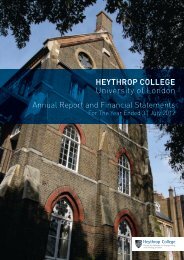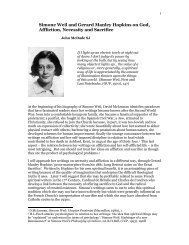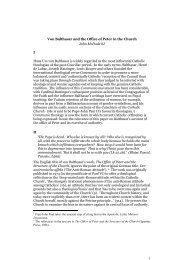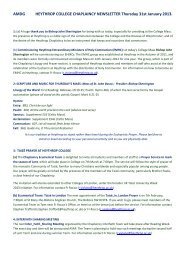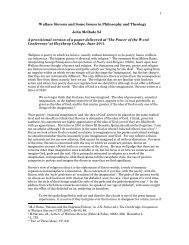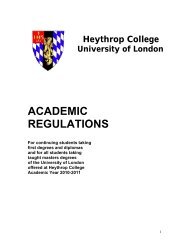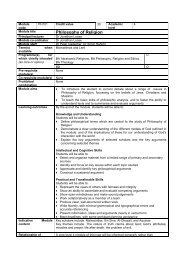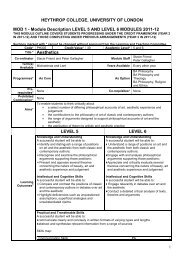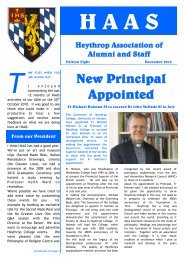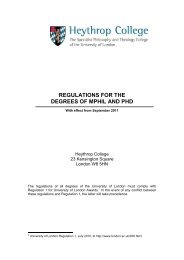November 2012 - Heythrop College
November 2012 - Heythrop College
November 2012 - Heythrop College
Create successful ePaper yourself
Turn your PDF publications into a flip-book with our unique Google optimized e-Paper software.
Film Review: The Gospel of Us<br />
In April 2011, over three days beginning<br />
on Good Friday, the town of Port Talbot in<br />
South Wales came together to stage The<br />
Passion through the streets with Michael<br />
Sheen as their Jesus-like figure. A year later,<br />
those three days of drama have been turned<br />
into a two hour film. The locals became<br />
the cast, crew and heroes of it and for this<br />
reason the film never feels ‘acted’ but<br />
instead harrowingly and stunningly real. It<br />
is hard for me to describe the film as I would<br />
not do its uniqueness justice – I have never<br />
seen anything quite like it. The editing style<br />
itself will stay with me before I can even<br />
think about Sheen’s magnetic presence as<br />
‘The Teacher’ who, much like the Jesus of<br />
the gospels, attracts and repels the crowd in<br />
equal measure.<br />
The setting of The Passion revolves around<br />
the fictional story of a battle that Port Talbot<br />
is fighting. Authoritarian forces have taken<br />
over and a ruthless, sinister corporation is in<br />
control, called ICU. They are after the town’s<br />
resources and a company man clashes with<br />
a suicide bomber on the beach. What could<br />
have been a bloody massacre is saved by a<br />
softly spoken loner who tells us later that he<br />
is here ‘to listen’ (The Teacher). He is a local<br />
man, who disappeared 40 days earlier, who<br />
has lost his memory. ICU seek to get rid of<br />
him since he is a trouble maker. The biblical<br />
parallels are at this point clear – certain<br />
figures are representative of the names we<br />
associate with the Easter story.<br />
At the screening I went to, Director Dave<br />
McKean and writer (of the book it was based<br />
on) Owen Sheers were present for a Q&A<br />
session post show, which offered great insight<br />
into the making of the film and how the<br />
project began via National Theatre Wales.<br />
Sheen, whose home town is Port Talbot,<br />
had wanted to do a secular response to The<br />
Passion – secular maybe, but the journey<br />
one is taken on through the film takes one<br />
into a sphere that is not of the everyday and<br />
yet the film is for everyman. The secular<br />
symbolism in the film is so profound, such<br />
as the sharing of Sheen’s sandwiches with<br />
some people who have started to follow him,<br />
and the conversation with his earthly dad, a<br />
roofer, about the value of a broken slate, is so<br />
striking, it made me feel that once I walked<br />
outside the cinema I would quite easily find<br />
the divine in just about anything. The film<br />
is an achievement in film making, acting and<br />
meaning, but Christian viewers may find it<br />
even more faith affirming (though it does not<br />
set out to do this) because of what it does<br />
8<br />
implicitly – I will take time to explain this.<br />
At one level, the film is an example of<br />
the omnipresence of technology in our lives<br />
and how this has had both a disturbing and<br />
creatively good impact on our lives. McKean<br />
didn’t anticipate the intrusion of phones of<br />
the ‘crowd’ in his face whilst he was trying<br />
to film and the filming of people filming with<br />
their phones adds a huge dynamic to the film<br />
because it then becomes a mirror in which<br />
society can look at itself. It is not a film<br />
about ‘how Port Talbot staged The Passion’ –<br />
it is a record of the three days of a man on a<br />
journey, unrehearsed. It overwhelms Sheen<br />
at one point – again, this is all recorded and<br />
shown in the film, who asks a man in the<br />
crowd why he is filming him on his phone<br />
(the man is being filmed filming – if that<br />
makes sense) and the man replies because he<br />
wants to be here. Sheen replies, as Sheen,<br />
‘then be here’; ‘be here with me’. What<br />
may have been seen as intrusive (a mobile<br />
phone) actually becomes a catalyst for the<br />
theme of the film and of Easter – be here, be<br />
present. The phone is a vehicle for asking<br />
us, are we present in this world to witness<br />
what is happening – do we relate to each<br />
other in a society of virtual reality where you<br />
can have a relationship involving no relating<br />
(the internet and phone) How brilliant the<br />
film is in using technology to record the last<br />
three days of this man’s life but at the same<br />
time using the very vehicle that has made<br />
the film what it is, to turn the phenomenon<br />
of technology on its head: beware of who<br />
and what your master is when looking for<br />
meaning in life.<br />
I hope I am enticing you to see this film.<br />
It is truly modern and yet timeless (like the<br />
gospels whether you are believer or not)<br />
because it is a story and a story told with<br />
all the truth of human emotion. It is also<br />
timeless because of its take on who The<br />
Teacher is. This you begin to see at the<br />
end of the film through a sequence of shots<br />
of Michael Sheen which he shot himself,<br />
whilst in isolation. They indicate isolation,<br />
brokenness and loneliness – I can’t say more<br />
for fear of spoiling the film, but all human<br />
life is here. And it is these themes that are<br />
continual through the film linked through the<br />
one main theme of memory. Sheen collects<br />
a core group of followers in the lead up to the<br />
Crucifixion who he ‘rescues’ – the first one in<br />
a very obvious way in the shape of a suicide<br />
bomber. All, like him, are struggling with<br />
some element of their past, often because<br />
they can’t remember or work out what went<br />
wrong – the film at these points – via each<br />
one’s story, is fractured and disturbing with<br />
dream-like sequences. The power of the<br />
film’s editing at these moments reflects the<br />
state of the characters’ minds so you’re not<br />
only seeing the power of the locals’ acting<br />
but the structure of the film illustrates this<br />
(McKean has a background in graphic design,<br />
illustration, sculpture and music and this is<br />
all evident by the way he’s made the film).<br />
Again, the deeper meaning is always there,<br />
Sheen says at one social gathering, to his lost<br />
yet found friends, ‘we find ourselves in each<br />
other’. It is through pain (both physical pain<br />
in mind and body in the here and now, and<br />
painful memories) that peace, understanding<br />
and often resolution can be found.<br />
The importance of the play on words<br />
‘ICU’ become clear – all those who follow<br />
Him, see him. He says to the suicide bomber<br />
‘I see you’ – you are found because you have<br />
been seen and through being seen, you see<br />
this Jesus-like figure and ultimately see<br />
yourself. The underlying spiritual truths are<br />
heartbreakingly moving.<br />
For me, it is not a ‘made’ film – it is one<br />
that evolves as the viewer’s response grows<br />
through it. Port Talbot was clearly sucked<br />
into the world of the play and if the crew just<br />
set out to give a secular response they have<br />
achieved a lot more. This is most evident<br />
in the Crucifixion when the crowd become<br />
‘the mob’ just by virtue of wanting to see<br />
Sheen and at those moments in the film,<br />
Owen Sheers spoke of the strange moral<br />
vacuum – Sheen is violently beaten, away<br />
from the crowds but the crowd watch on big<br />
screens – people are still filming the whole<br />
event on their phones which can be seen as<br />
disgusting and when this is continued at the<br />
actual Crucifixion you feel it is then simply<br />
wrong, and yet the artistic effect of the Dalilike<br />
Christ hanging above Port Talbot with the<br />
thousands of camera phones flashing looks<br />
like stardust, and the blood and screaming<br />
of the event has transpired into a mystical<br />
spectacle.<br />
The longer the film stays in my mind, the<br />
more metaphors and truths about life walk<br />
into my mind. Port Talbot is in a battle for its<br />
life as the film opens, a battle for its identity<br />
– it is a town scarred by the M4 motorway –<br />
this is its story, its ‘mark’, or a blot on the<br />
landscape (it appears in one of the dream<br />
sequences as ‘the monster with stone legs’),<br />
and the town is desperate to ‘reremember’<br />
itself. To say The Teacher takes on the scars<br />
of the motorway in his bearing of another<br />
kind of monster (the cross) is not taking<br />
the symbolism too far, because human kind<br />
essentially looks for identity and if this is<br />
being taken away, people feel desperate and<br />
perform actions which don’t make sense. It<br />
is not for nothing that the words ‘I Am’ are<br />
uttered in the film, the full meaning of them<br />
and the context in which they were said<br />
continues to resonate days after viewing the<br />
film.<br />
Anna Wheeler<br />
BA Theology 2003



